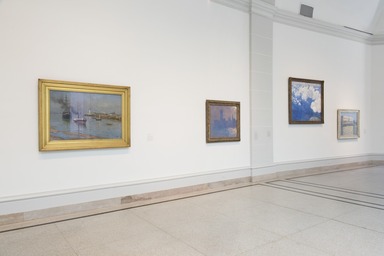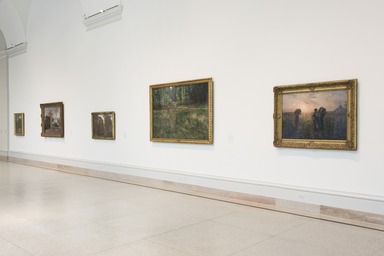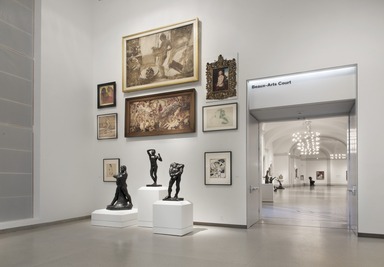

European Art, April 08, 2016 through Current (Image: DIG_E_2016_European_Art_01_PS11.jpg Brooklyn Museum photograph, 2016)

European Art, April 08, 2016 through Current (Image: DIG_E_2016_European_Art_02_PS11.jpg Brooklyn Museum photograph, 2016)
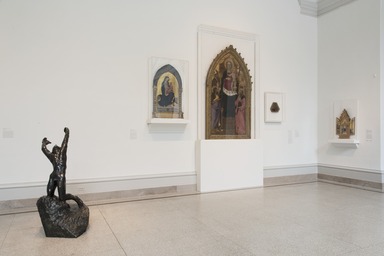
European Art, April 08, 2016 through Current (Image: DIG_E_2016_European_Art_03_PS11.jpg Brooklyn Museum photograph, 2016)
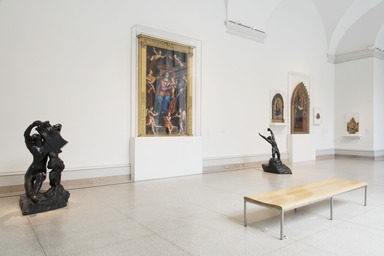
European Art, April 08, 2016 through Current (Image: DIG_E_2016_European_Art_04_PS11.jpg Brooklyn Museum photograph, 2016)
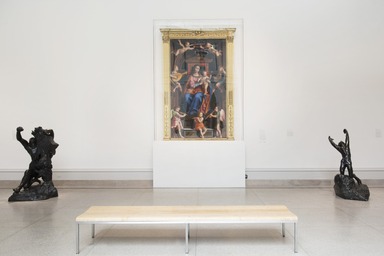
European Art, April 08, 2016 through Current (Image: DIG_E_2016_European_Art_05_PS11.jpg Brooklyn Museum photograph, 2016)

European Art, April 08, 2016 through Current (Image: DIG_E_2016_European_Art_06_PS11.jpg Brooklyn Museum photograph, 2016)
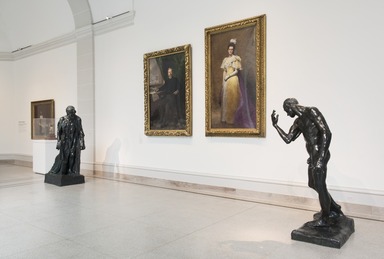
European Art, April 08, 2016 through Current (Image: DIG_E_2016_European_Art_07_PS11.jpg Brooklyn Museum photograph, 2016)
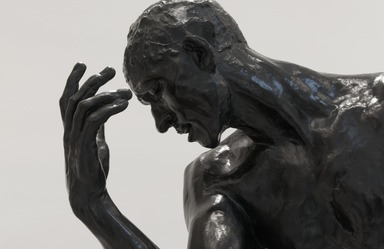
European Art, April 08, 2016 through Current (Image: DIG_E_2016_European_Art_08_PS11.jpg Brooklyn Museum photograph, 2016)
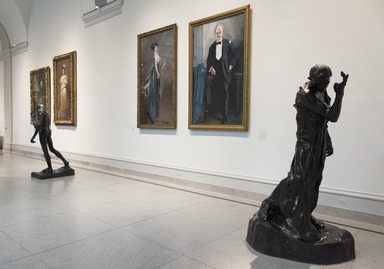
European Art, April 08, 2016 through Current (Image: DIG_E_2016_European_Art_09_PS11.jpg Brooklyn Museum photograph, 2016)
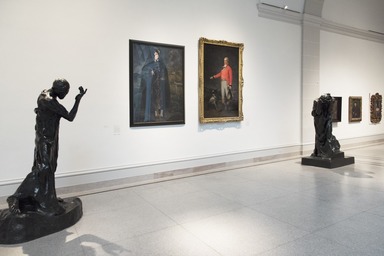
European Art, April 08, 2016 through Current (Image: DIG_E_2016_European_Art_10_PS11.jpg Brooklyn Museum photograph, 2016)
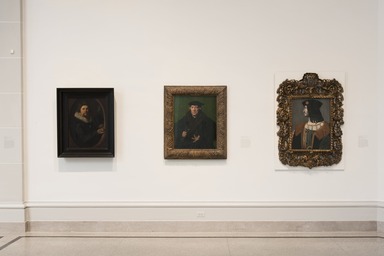
European Art, April 08, 2016 through Current (Image: DIG_E_2016_European_Art_11_PS11.jpg Brooklyn Museum photograph, 2016)
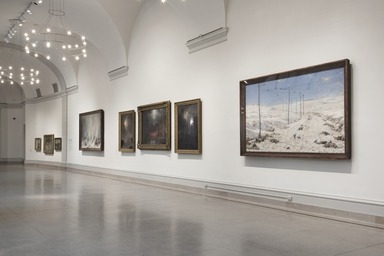
European Art, April 08, 2016 through Current (Image: DIG_E_2016_European_Art_12_PS11.jpg Brooklyn Museum photograph, 2016)
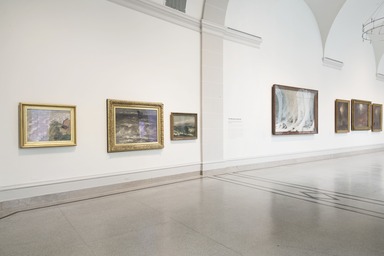
European Art, April 08, 2016 through Current (Image: DIG_E_2016_European_Art_13_PS11.jpg Brooklyn Museum photograph, 2016)
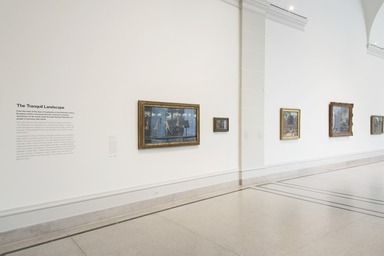
European Art, April 08, 2016 through Current (Image: DIG_E_2016_European_Art_14_PS11.jpg Brooklyn Museum photograph, 2016)
European Art
-
The Nude
The Western nude, a longstanding tradition reflecting a male-dominated culture, is one of the themes that has been mined by European artists to define themselves and their world.
In the Renaissance, artists revived the classical tradition of representing the nude, inspired by the discovery of ancient Greek and Roman sculpture, as well as a new scientific interest in nature and anatomy. Initially, the Renaissance nude was presented in historical, mythological, or religious contexts, as seen here in paintings by Pieter Pourbous and Lucas Cranach.
The revival of the classical nude continued almost uninterrupted through the nineteenth century, when Realist masters began to remove the naked body from its historical context. Male artists nevertheless continued to portray the female nude, in particular, as an object of desire. By the early twentieth century, following two world wars, European avant-garde artists fully broke from classical tradition, emphasizing formal experimentation and psychology in the modern nude. -
Two Portraits of the Ballerina Eugenie Fiocre
Eugénie Fiocre (1845–1908) became one of the most accomplished ballerinas of the nineteenth century, renowned for her beauty and many admirers as much as for her dancing. At the height of her celebrity in the late 1860s, two French artists captured the young star’s persona in the works on view here.
Edgar Degas’s painting, made for the 1868 Salon, was the first of his many works focusing on contemporary ballet and its performers. He depicted Mlle Fiocre in her role as princess Nouredda in the ballet La Source. The production at the Paris Opéra astonished audiences with its exotic costumes and spectacular sets, including a hydraulic-powered running stream and live horses, and provided fodder for caricaturists (see illustrations).
Degas shows Eugénie Fiocre during a pause in rehearsal. She sits in a meditative, even melancholic pose, in full costume save her cast-off pink ballet slippers on the ground behind her. Mixing stage artifice and psychological naturalism, Degas captures his sitter as both character and individual, in a transitional moment between the imagined place and time of the ballet and the private reveries of the present.
Jean-Baptiste Carpeaux’s plaster portrait bust of the dancer is one of a number of reduced versions he made of a marble sculpture he exhibited at the Salon that year. It was praised for its lively, expressive features and sensual form, described by one writer as “so real that it makes one’s spine tingle, so intimate is the flesh.” Degas appreciated the work, too, and one of his friends recounted how the painter liked to handle a reduced version of it: “He liked to take it in his hands and, without being distracted from listening, touched and caressed the ravishing nape and back.” Mlle Fiocre was so delighted with the portrait that she would later commission Carpeaux to create another sculpture of her dancing in one of her favorite roles.
Like Degas’s painting, Carpeaux’s portrait connects the imaginary and the real. In its idealized elegance the bust recalls French Rococo art of the previous century. The captivating dancer from humble beginnings may not be wearing a stage costume, but she is nonetheless portrayed in a role—fashionable aristocrat. This bit of artifice would become reality: unlike many nineteenth-century ballerinas who fell into poverty and prostitution, Eugénie Fiocre became wealthy and eventually married into a noble French family. -
The Sacred: Religious Art
With the dominance of Christianity by the Middle Ages, religious subject matter held sway in European art, expressing a yearning for spiritual salvation.
In the Renaissance, privileged private citizens joined high-ranking church officials in commissioning sacred artworks for public and private consumption. The central and northern Italian paintings and sculptures on this wall originally adorned church altars, family chapels, and private rooms in Italian residences, reinforcing the role of religion in everyday life. The works celebrate the life of saints—above all the Virgin Mary, who served as both a model of piety and an intermediary between the earthly and celestial realms.
In the late nineteenth century, Auguste Rodin was inspired by the religious art of the Italian Renaissance, especially that of Michelangelo. Rodin’s muscular nudes bring intense emotional expression to religious themes. -
The Secular: Portraiture
European portraits, originally accessible only to the wealthiest aristocrats, recorded likenesses and also conveyed the position, prestige, and social values of the sitters.
With the rise of the merchant class during the Renaissance, a broader privileged group revived the portrait. These patrons favored distinctive representations that brought their personalities to life.
Representations of men and women were also commissioned for public consumption, often as inspiring symbols of civic pride. Auguste Rodin’s life-size bronze versions of The Burghers of Calais depict some of the six prominent citizens who in 1347 were willing to die to free their French city from English occupation. -
The Menacing Landscape
In times of war and natural disaster, painters interpreted their shifting physical world through haunting depictions of Europe’s terrain.
Countering the eighteenth-century Enlightenment ideals of liberty, progress, and reason, the British philosopher Edmund Burke formulated the concept of the Sublime, a view of nature as vast, magnificent, and terrifying.
The paintings on this wall present nineteenth- and twentieth-century variations on the menacing and awe-inspiring landscape of the Sublime. All feature nearly uninhabited views in which nature dominates the individual through rising tides, annihilating snowstorms, and volcanic eruptions.
In Vasily Vereshchagin’s monumental paintings of the Russo-Turkish War in the late 1870s, humans are rendered defenseless against the unbridled force of nature. By the twentieth century, avant-garde painters responded to a Europe fractured by two world wars by introducing new styles such as Cubism and Surrealism. Their landscapes speak to the irrationality of war and postwar existential crisis. -
The Tranquil Landscape
From the start of the Age of Exploration in the fifteenth century, European artists communicated the continent’s growing dominance on the world stage through idealized depictions of people in harmony with nature.
This wall features four centuries of tranquil European landscapes. The landscape first emerged as an independent category of painting in the Renaissance, taking root in the Danube River Valley, Venice, and Antwerp. These idealized works were peopled with figures from past and present.
In seventeenth-century Holland, landscapes became more naturalistic, often based on drawings executed on-site, and they served as proud, faithful records of everyday life. In the late eighteenth and nineteenth centuries, artists in Italy and France began to paint outdoors (en plein air), capturing fleeting effects of atmosphere and light in pastoral settings with loose, broken brushstrokes. In the early twentieth century, before the outbreak of World War I, Claude Monet and other French Impressionists won over Europe’s increasingly wealthy middle class with bold color and radical brushwork in personal views of the continent during a brief period of calm.
-
April 1, 2016
A signed, historical copy of the Emancipation Proclamation will be on view for three months as part of the American Galleries reopening
ASK, the Museum’s app, now available on Android and iPhone
The Brooklyn Museum is pleased to announce that its American and European galleries have been refreshed and reorganized, while two-thirds of its unparalleled Egyptian galleries have been reinstalled with a new thematic structure. These are the first reinstallations of the Museum’s permanent collection galleries since 2003, and they represent the first collection initiative launched under the leadership of Anne Pasternak since her appointment seven months ago as the Museum’s Shelby White and Leon Levy Director. Pasternak commented, “It’s time to revisit the Brooklyn Museum’s extraordinary collections, which span more than five thousand years of human creativity. And this is just the beginning, as Team Brooklyn Museum sets out to pursue our greatest potential and takes a fresh look at our incredible collections—while also conceiving new, special exhibitions and inciting conversations about some of the important topics in our borough, our city, and all across the globe.” The Brooklyn Museum will celebrate the reopenings at its annual fundraiser, the Brooklyn Artists Ball, on April 20.
New developments include reinstalled American art galleries that embrace a more inclusive view of history and geography, and recognize the shifting demographics of this country. Additional changes include the reorganized East Wing galleries of ancient Egyptian art, which have been restored to the original proportions designed by the architects McKim, Mead & White. While opening up new perspectives on Egypt as an African culture, the galleries will also incorporate a special contemporary art project for the first time, demonstrating the continuing importance of the ancient world to the artists of today.
At the same time, the reconfigured European gallery, housed in the Beaux-Arts Court, has been rehung thematically with works that now span a wide range of mediums, including sculpture and works on paper, in addition to painting.
Pasternak continued: “Our staff worked collaboratively to redefine our galleries so that visitors can have a fresh look at the masterpieces in our collection, seeing their own personal histories reflected in these works of art, and learning about the histories of others.”
Additionally, with support from Bloomberg Philanthropies, visitors can now experience the full interactive capabilities of the Museum’s unique ASK app, which connects visitors with art experts in real time, now available on iPhone and Android.
American Galleries
The reinstalled American art galleries (formerly called American Identities) will explore the overarching theme “What constitutes American art?,” taking a more Pan-American and cross-cultural view. The new installation, chronologically arranged, is made up of eight sections: “The Americas’ First Peoples”; “From Colonies to States”; “Imagining the New Nation’s Landscape”; “Visions and Myths of a Nation”; “Nations Divided”; “The United States on the World Stage”; “The City and the Rise of the Modern Woman”; and “Beyond Borders and Boundaries.”
In the reinstallation, the Museum is pleased to display such recent acquisitions as John Carroll, Showgirl (1929) and Daniel Cottier and Tiffany & Company, Clock (1883). Major works on view include Gilbert Stuart, George Washington (1796); Albert Bierstadt, A Storm in the Rocky Mountains, Mt. Rosalie (1866); a Maya artist’s Figure Emerging from a Waterlily (600–900); Herter Brothers, Cabinet (circa 1872); and Red River Metis or Yanktonai Sioux artist, Dress Shirt (before 1830). Curator Connie H. Choi notes, “Our presentation offers a more balanced view and tells different stories, featuring themes that address cross-cultural influences as well as historical issues of racial discrimination and urbanization. In these ways, the installation expands on questions confronting many Americans today.” Among the wide-ranging list of artists and artisans featured are John Biggers, Miguel Cabrera, William Merritt Chase, John Singleton Copley, Beauford Delaney, Thomas Eakins, Carol Emarthle-Douglas, William Glackens, Winslow Homer, Edward Hopper, Maria Martinez, Isamu Noguchi, Georgia O’Keeffe, Diego Rivera, John Singer Sargent, Florine Stettheimer, Mickalene Thomas, Tiffany & Company, and Union Porcelain Works.
Conservation efforts have made it possible for the American galleries to include such Pan-American works as Devotional Cross (19th century) from Mexico, and Carved Pilaster from Our Lady of Guadalupe (18th century) from Zuni Pueblo, New Mexico.
As part of the reopening, the Museum will display a historical, signed copy of the original Emancipation Proclamation for three months. The proclamation, first signed by Abraham Lincoln in 1863, freed all enslaved Africans in states then in rebellion, providing a legal framework for the eventual emancipation of millions of others. The official manuscript is in the National Archives in Washington. The copy, on loan from a private collector, is one of forty-eight versions, individually signed by Lincoln, in the Leland-Boker edition of 1864, sold to benefit Union soldiers who fought in the Civil War.
Ancient Egyptian Galleries
One of the most visited areas in the Brooklyn Museum, the ancient Egyptian galleries house a world-famous collection frequented by tourists, school groups, and new and returning visitors alike. The Museum began collecting Egyptian antiquities in 1902, with most of the art now in the galleries arriving in New York during the nineteenth century in private collections before their later transfer to the Museum.
Over the years, renovations in the Egyptian galleries have included a 1993 reorganization, which told the story of Egyptian art from the Amarna Period (circa 1352 B.C.E.) until the time of Roman rule (30 B.C.E.–395 C.E.). An expansion of the galleries, in April 2003, made it possible to introduce art from Egypt’s earliest known origins (circa 3500 b.c.e.) until the later Eighteenth Dynasty. The widely popular Mummy Chamber installation opened in 2010.
For the 2016 reinstallation, two-thirds of the Egyptian permanent galleries (formerly known as Egypt Reborn) will incorporate new themes that recognize the significance of African culture to the Nile Valley; the multicultural nature of Egyptian society; and its close but complex relationship with nearby Nubia. Important changes to the galleries include the removal of re-creations of Egyptian architectural elements, allowing for a newly reconfigured open floor plan. And for the first time, a contemporary art work, Lorraine O’Grady’s Miscegenated Family Album (1994), will be incorporated into these galleries, to establish a dialogue between the past and the present.
Curator Edward Bleiberg notes, “The new aesthetic of the galleries directs visitors to the art and brings out the natural beauty of the subtle Egyptian colors. The ancient artists created these works with specific light levels in mind. It is important not to set them ablaze with such dazzlingly bright spotlights as to distort their intended appearance. They are best seen, as they were meant to be, with raking light as if from a torch. This will finally be possible in our new galleries.”
In total, the ancient Egyptian galleries boast more than 1,600 objects. Significant works on view include Amunhotep III (circa 1390–1352 B.C.E.); Statuette of Ankhnesmeryre II and Her Son, Pepy II (circa 2288–2224 or 2194 B.C.E.); King as Child Protected by Goddess (circa 700–670 B.C.E.); A Prince of Tekhet (circa 1479–1400 B.C.E.); and Figure of a Bound Foreign Prisoner (circa 1979–1801 B.C.E.).
European Gallery
The European art gallery (formerly known as European Painting), housed in the Museum’s Beaux-Arts Court and its third-floor lobby, features 63 artworks, including Frans Hals, Portrait of a Man (circa 1614–15); Francisco de Goya, Portrait of Don Tadeo Bravo de Rivero (1806); Edgar Degas, Nude Woman Drying Herself (circa 1884–86); and Claude Monet, Houses of Parliament (1903). Curator Richard Aste explains, “The unifying theme here is European identity-making through the body, faith, fashion, and a shifting sense of place.” New thematic sections include “The Nude”; “The Sacred: Religious Art”; “The Secular: Portraiture”; “The Menacing Landscape”; and “The Tranquil Landscape.” And now, for the first time, works in the gallery will span all major artistic mediums represented in the collection: paintings, sculpture, and works on paper, which make up half of Brooklyn’s holdings of European art. Ten sculptures from the Museum’s collection of sixty sculptures and works on paper by Auguste Rodin will be relocated from the Entrance Pavilion to the galleries, to join the historical dialogue of the male and female form, dressed and nude, in this complete reinstallation, the first since 2003. Additional artists whose works are on view include Lucas Cranach, Gustave Courbet, Henri Fantin-Latour, Paul Gauguin, Edvard Munch, Egon Schiele, and Yves Tanguy.
Rethinking the hanging of the gallery space led to the removal of obstructive guardrails and the installation of improved lighting. Conservation support for the project made possible the reframing of the Degas and Hals paintings; the stabilizing of historical frames; the stabilization of Gauguin’s Tahitian Woman (1894) using a consolidant/adhesive; and the addition of non-reflective Optium Acrylic glazing to reduce glare, letting visitors see the works more clearly.
The Brooklyn Museum’s ASK App
This April, “ASK Brooklyn Museum”—the Museum’s pioneering app, which enables visitors to interact in real time with Museum experts—will be fully functional on both Android and iPhone. The app is funded by Bloomberg Philanthropies through its Bloomberg Connects program, a global initiative that helps cultural institutions to innovate and engage audiences through digital platforms.
Free to download on both iPhones and Androids, ASK enables visitors to pose questions about any work of art on view at the Museum and receive answers from the Audience Engagement Team in real time, providing a tailored, on-site educational experience. The app’s design is based on the look of Apple’s iMessage, to offer a simple and familiar communications interface that is both kid- and adult-friendly. Using location-aware technology, the app pinpoints the visitor’s precise whereabouts in the galleries, helping the Museum team to better answer questions and recommend other objects of interest nearby.
“ASK uses a very simple mechanism of asking a question and leverages that engagement, so we can learn more about how visitors are experiencing the Museum,” said Shelley Bernstein, Vice Director for Digital Engagement and Technology. “This is helping our curators see what’s working best and where we can make refinements for greater clarity.”
About the Brooklyn Museum
The Brooklyn Museum has long been at the forefront of engagement with underserved and younger audiences, from its widely popular Target First Saturday program and creative reinstallations of its permanent collection, to its pioneering online presence and inventive use of technology in reimagining the visitor experience. A driving force behind the massive growth and energy of the Borough of Brooklyn and of its diverse cultural community, the half a million annual visitors to the Brooklyn Museum make up one of New York’s most inclusive museum-going audiences.
With roots dating back to 1823, the Brooklyn Museum is among the oldest and largest art museums in the United States, with a collection representing nearly every culture, ranging from some of the most important ancient Egyptian works in the nation, to the arts of the Pacific Islands, Asia, Africa, the Islamic world, and Native American art, to U.S. and European art, and international contemporary works. The Museum is home to the Elizabeth A. Sackler Center for Feminist Art, the only facility of its kind in the country.
The Museum has developed a broad schedule of special exhibitions, from scholarly to popular-culture offerings. Its critically acclaimed spring 2016 season features Tom Sachs: Boombox Retrospective, 1999–2016; Disguise: Masks and Global African Art; This Place; and Agitprop! The Museum reaches audiences across the country and internationally with a robust schedule of traveling exhibitions, often drawn from its own collections, among them the current tours of Kehinde Wiley: A New Republic; Killer Heels: The Art of the High- Heeled Shoe; and Basquiat: The Unknown Notebooks. The Museum also hosts extraordinary touring shows in partnership with other world-class institutions. Upcoming exhibitions organized by the Brooklyn Museum include Who Shot Sports: A Photographic History, 1843 to the Present and Iggy Pop Life Class: A Project by Jeremy Deller.
This installation of the Brooklyn Museum’s American Art collection is organized by Connie H. Choi, Assistant Curator of American Art, with Barry R. Harwood, Curator of Decorative Arts; Nancy Rosoff, Andrew W. Mellon Curator of the Arts of the Americas; Susan Kennedy Zeller, Associate Curator of Native American Art; and Richard Aste, Curator of European Art.
Generous support for the installation of the American galleries as a part of the Brooklyn Museum’s Countdown to Launch initiatives is provided by Barbara and John Vogelstein, Dana Ben-Ari and Nikola Duravcevic, Tamara and Gregory Belinfanti, and Leslie and Alan Beller.
This installation of the Brooklyn Museum’s Ancient Egyptian Art collection is organized by Edward Bleiberg, Curator of Egyptian Art, with Yekaterina Barbash, Associate Curator of Egyptian Art.
Generous support for the installation of the Introduction and Early Egypt galleries as a part of the Brooklyn Museum’s Countdown to Launch initiatives is provided by the Elizabeth A. Sackler Museum Educational Trust, the Jerome Levy Foundation, the Frederick and Diana Elghanayan Family Foundation, and Richard A. Fazzini and Mary E. McKercher.
This installation of the Brooklyn Museum’s European Art collection is organized by Richard Aste, Curator of European Art.
Generous support for the installation of the European galleries as a part of the Brooklyn Museum’s Countdown to Launch initiatives is provided by Leslie and Alan Beller.
Press Area of Website
View Original
